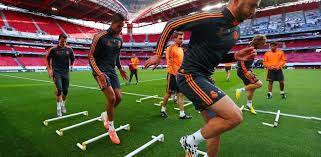
Rejuvenation Routines: Effective Recovery and Regeneration Activities for Football Players”
Introduction: Recovery and regeneration are integral components of a football player’s training routine, helping to minimize fatigue, reduce the risk of injuries, and optimize overall performance. This guide outlines a series of proven recovery and regeneration activities that coaches can incorporate into their post-training or post-match sessions to enhance players’ physical and mental well-being.
Recovery and Regeneration Activities:
1. Cool Down and Stretching (10 minutes):
- Light Jogging: Gradually reduce the intensity with a gentle jog around the field.
- Dynamic Stretching: Incorporate dynamic stretches for major muscle groups, focusing on flexibility and range of motion.
- Static Stretching: Hold static stretches for key muscle groups, emphasizing breathing and relaxation.
2. Hydration and Nutrition (Ongoing):
- Hydration: Encourage players to rehydrate with water or electrolyte-rich beverages immediately after training or a match.
- Nutrition: Provide access to nutrient-rich snacks or meals containing a balance of carbohydrates, proteins, and essential vitamins.
3. Cold Water Immersion (5-10 minutes):
- Ice Baths or Cold Showers: Submerge players in cold water or encourage cold showers to reduce muscle soreness and inflammation.
- Contrast Therapy: Alternate between cold and warm water to enhance circulation and accelerate recovery.
4. Foam Rolling and Self-Myofascial Release (10 minutes):
- Foam Roller Sessions: Instruct players to use foam rollers to target tight or sore muscles, promoting flexibility and reducing muscle tension.
- Self-Massage Techniques: Incorporate self-massage techniques using massage balls or handheld massagers for specific muscle groups.
5. Active Recovery Exercises (15 minutes):
- Low-Intensity Exercises: Include activities such as light cycling, swimming, or walking to promote blood flow without placing excessive strain on muscles.
- Mobility Drills: Integrate gentle mobility exercises to enhance joint flexibility and maintain a full range of motion.
6. Compression Garments (Optional):
- Compression Socks or Sleeves: Players may choose to wear compression garments to aid in reducing muscle soreness and improving circulation.
- Recovery Boots: Implement pneumatic compression devices for a targeted and controlled compression experience.
7. Mindfulness and Relaxation (10 minutes):
- Breathing Exercises: Guide players through deep breathing exercises to promote relaxation and reduce stress.
- Meditation or Visualization: Introduce short sessions of mindfulness, meditation, or visualization to enhance mental recovery.
8. Sleep Hygiene (Ongoing):
- Encourage Quality Sleep: Emphasize the importance of consistent and sufficient sleep for optimal recovery and performance.
- Sleep Environment: Provide tips on creating a conducive sleep environment, including cool temperatures and reduced light exposure.
9. Recovery Pools or Hydrotherapy (Optional):
- Hydrotherapy Sessions: If available, incorporate sessions in hot tubs, jacuzzis, or cold plunge pools to facilitate muscle relaxation and recovery.
10. Individualized Treatment (As Needed):
- Physical Therapy: Address individual player needs by offering access to physical therapy sessions for specific injuries or concerns.
- Massage Therapy: Provide opportunities for players to receive professional massages to target muscle tightness and promote recovery.
Implementation Tips:
- Rotate recovery activities to keep routines varied and engaging.
- Individualize activities based on player feedback, injuries, or specific needs.
- Educate players on the importance of consistent recovery practices.
Conclusion:
Prioritizing recovery and regeneration activities is essential for sustaining high-performance levels throughout the football season. Coaches should work collaboratively with players to integrate these activities into the overall training regimen, ensuring a holistic approach to player well-being and long-term success on the field.
